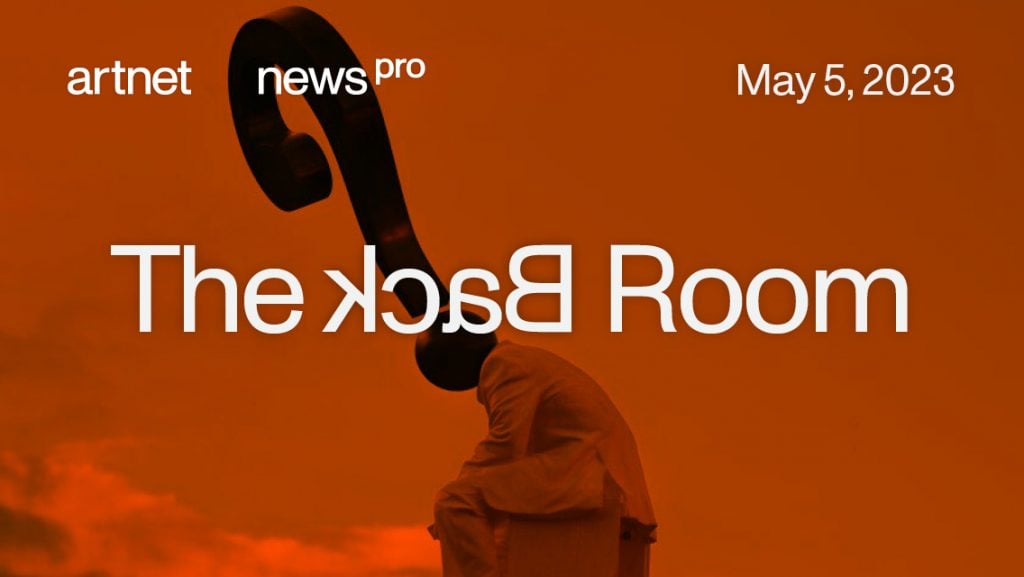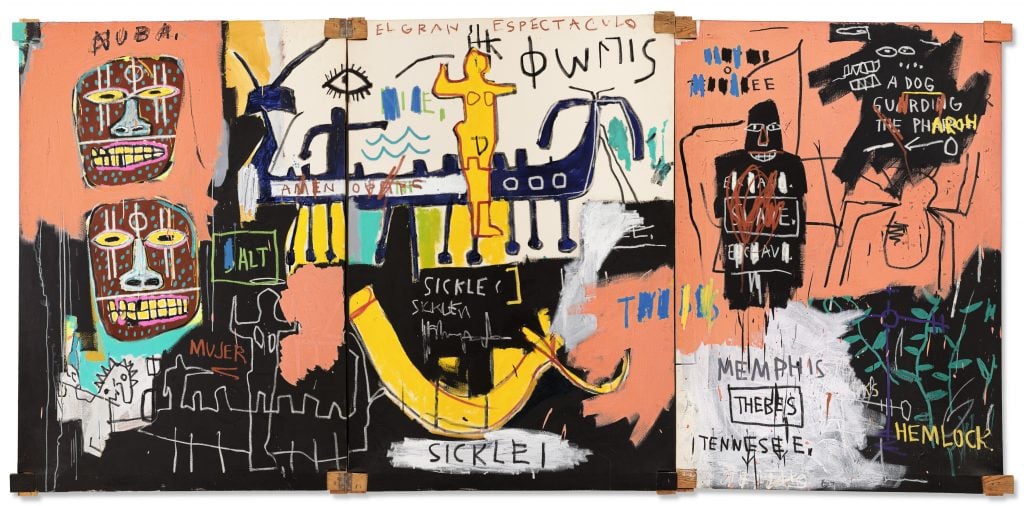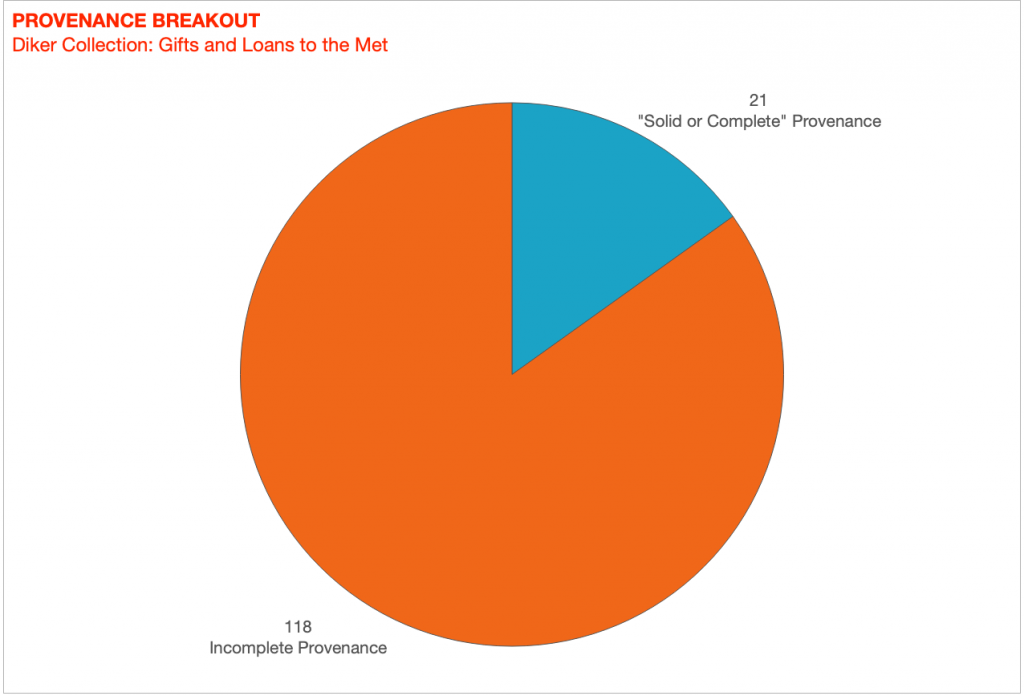The Back Room
The Back Room: Will May Go the Market’s Way?
This week: a temperature check before May’s market mania, the museum director carousel keeps spinning, anxiety in the antiquities market, and much more.

This week: a temperature check before May’s market mania, the museum director carousel keeps spinning, anxiety in the antiquities market, and much more.

Artnet News

Every Friday, Artnet News Pro members get exclusive access to the Back Room, our lively recap funneling only the week’s must-know intel into a nimble read you’ll actually enjoy.
This week in the Back Room: a temperature check before May’s market mania, the museum director carousel keeps spinning, anxiety in the antiquities market, and much more—all in a 7-minute read (1,933 words).
__________________________________________________________________________

Jean-Michel Basquiat, El Gran Espectaculo (The Nile) (1983). Estimate on request; in the region of $45 million. Courtesy Christie’s Images Ltd 2023.
Tim here. Fears of a downturn have been stalking the art market from major sales event to major sales event, global city to global city, for at least the past six months—and, by some accounts, a year or more.
And yet, even amid these choppy macroeconomic conditions, it seems that industry players are charging into the next three weeks of New York art fairs, auctions, and primetime gallery openings with mentalities remarkably similar to those they exhibited a season or two ago.
We can debate whether it would be more accurate to call the prevailing sentiment “cautious optimism” or “optimistic caution.” But either way, the point is the same: although the uppermost layer of froth may have fizzled out, there’s still enough effervescence in the glass to hold off the worst worries until later.
Dealers may not have cleaned up at the 2022 edition of Art Basel Miami Beach the way they have in true boom years, but the succeeding months have reinforced that, for the most part, business was good enough to keep the wheel turning.
Multiple collectors focused on different levels of the market told me that they have seen no discernible erosion in the overall mood between the first major market events of the new year and now. One Los Angeles-based advisor said that they sold more art in the first four months of 2023 than in the last six months of 2022.
Physical gallery expansions are still being announced at a steady clip, from Tribeca and Los Angeles, to London and Paris, to Asia and beyond. Rosters keep scaling up throughout the commercial hierarchy and across regions, too. Far more new spaces are forming than existing ones are shuttering.
Subtler but no less important an indicator of the market’s health is that, when it comes to hiring, it’s an applicant’s market
“In London at least, good support staff are hard to get: people keep asking me if I know a good registrar, a good sales associate,” Morgan Long, managing director of the Fine Art Group, said. “That’s not what happens when things are bad. That’s a sign that business is happening.”
What about the fairs? Every major expo slated for May and June, including the upcoming editions of Frieze New York, Independent, TEFAF New York, and Art Basel, is returning with more exhibitors than its 2022 iteration. For every fair that died in the first quarter, a new one has sprouted up to take its place.
The consensus review of Christie’s and Sotheby’s upcoming offerings is that they’re generally strong and crowd-pleasing, despite lacking the sort of crown jewels in the collections of Paul Allen and other big-name, recently deceased patrons whose wares were auctioned last May and November. Recent auction cycles in London and Hong Kong showed no obvious vulnerabilities.
Over the weekend, federal regulators seized struggling First Republic Bank and swiftly sold it off to JPMorgan Chase at a bargain price. First Republic is now the third regional U.S. bank to go down for the count this year, after Silicon Valley Bank and Signature Bank.
Just as important, one of the main culprits behind these bank failures just got even more aggressive. The Federal Reserve raised interest rates another quarter-point on Wednesday, taking the target federal funds rate above five percent for the first time since 2007—a disorienting reversal from March 2022, when it hovered near zero.
Ken Jacobs, chairman and CEO of investment bank Lazard, said on a recent earnings call that mergers-and-acquisitions activity had not been this subdued since 2012. The IPO market continued to slide, too: the number of companies to go public in the first quarter of 2023 was down 8 percent YOY, while the total cash they raised was down an unsettling 61 percent YOY, per Ernst and Young.
But the S&P 500, Nasdaq, and Dow Jones were all up YTD as of filing time. What’s more, old expectations about the wider economy’s relationship to the art economy may no longer apply.
While the art market is still small in the grand scope of other industries, there’s no denying that the past 10 to 15 years have seen a significant expansion in the buyer base.
Whether the primary motivator is a juicy return, social capital, or a quasi-religious pursuit of aesthetic transcendence, more wealthy people than ever are in the arena for establishment-approved artworks. The relative size of the buying audience will always be larger during clear market upswings, but its absolute size in the 2020s dwarfs its equivalent at a similar point in the business cycle a generation ago.
One consequence of this shift may be that the price floor at nearly every tier of the market has been raised for good. Even when market conditions suggest that the optimal move is to hunt bargains, there will be more opportunists pursuing those bargains than there used to be.
Which means that the bargains simply aren’t likely to get as cruel and offensive to the seller (and thus, as lucrative for the buyer) as they used to.
And when market conditions seem decent-to-favorable? Try not to lose a limb in the frenzy.
__________________________________________________________________________
Investors still appear to be wary of vulnerabilities in smaller American banks. The U.S.’s two major political parties are once again playing chicken with the country’s debt ceiling, raising the prospect that the nation could default by June 1 and upend the global financial picture. Stock market dips during auction week scare American bidders to a unique degree, Long of the Fine Art Group said.
And yet, just because reasonable professionals can imagine something finally knocking the art world off its axis doesn’t make it any more likely to happen than last winter, or last fall, or last summer, or last spring—or whenever it was that you, personally, first heard someone you trust hedge on how much longer the good times (or at least the good-enough times) would keep rolling.
Based on the evidence I’ve seen and the dynamics of this strange market we’ve created, the truly stunning question to mull at this point isn’t “When will the other shoe drop?” It’s “What if the worst of what we’ve been bracing for is already over?”
____________________________________________________________________________
The latest Wet Paint tracks the gossip surrounding a slew of directorial moves at some of the country’s top institutions, and memorializes Public Access, former Marlborough director Leo Fitzpatrick’s project space on Henry Street.
Here’s what else made a mark around the industry since last Friday….
Art Fairs
Auction Houses
Galleries
Institutions
Tech and Legal News
____________________________________________________________________________
“Why would Christie’s have this auction and not tell people? It’s infuriating to me. I would never buy jewelry from this person. As a Jewish person and as a human being, I think it’s terrible.”
—Cathy Lasry, wife of billionaire financier Marc Lasry, on Christie’s initial reticence to publicize the Nazi roots of the Heidi Horten jewelry collection, which the house expects to sell for up to $150 million this month. Horten’s first husband, Helmut Horten, was a Nazi party member whose wealth came in no small part from the takeover of Jewish companies. Christie’s has since updated its documentation and pledged to donate “a significant contribution from its final proceeds” to an organization dedicated to Holocaust research and education. (Artnet News Pro)
____________________________________________________________________________

Data from ProPublica. Visualization © 2023 Artnet Worldwide Corporation.
The Met has absorbed plenty of heat over its antiquities collections lately, and a recent report by ProPublica turns up the temperature on a major gift of Native American works from New York collectors Charles and Valerie Diker. The dispute serves as a microcosm of how contemporary standards are complicating, if not endangering, the trade in ancient objects across regions…
In response to ProPublica, the Met stated that it is misleading to use “complete ownership histories as a standard for judging a collection,” and outlined multiple new measures it has undertaken since 2021 to strengthen its research efforts and tribal relationships.
The Dikers said in a statement that their acquisition strategy “has always centered on proceeding carefully, assessing all available information relating to provenance before acquiring a work, and welcoming new information should it come to light.”
No matter what, though, the burden of proof in the antiquities market has clearly shifted—and it’s highly unlikely to revert back to its old boundaries.
—Tim Schneider